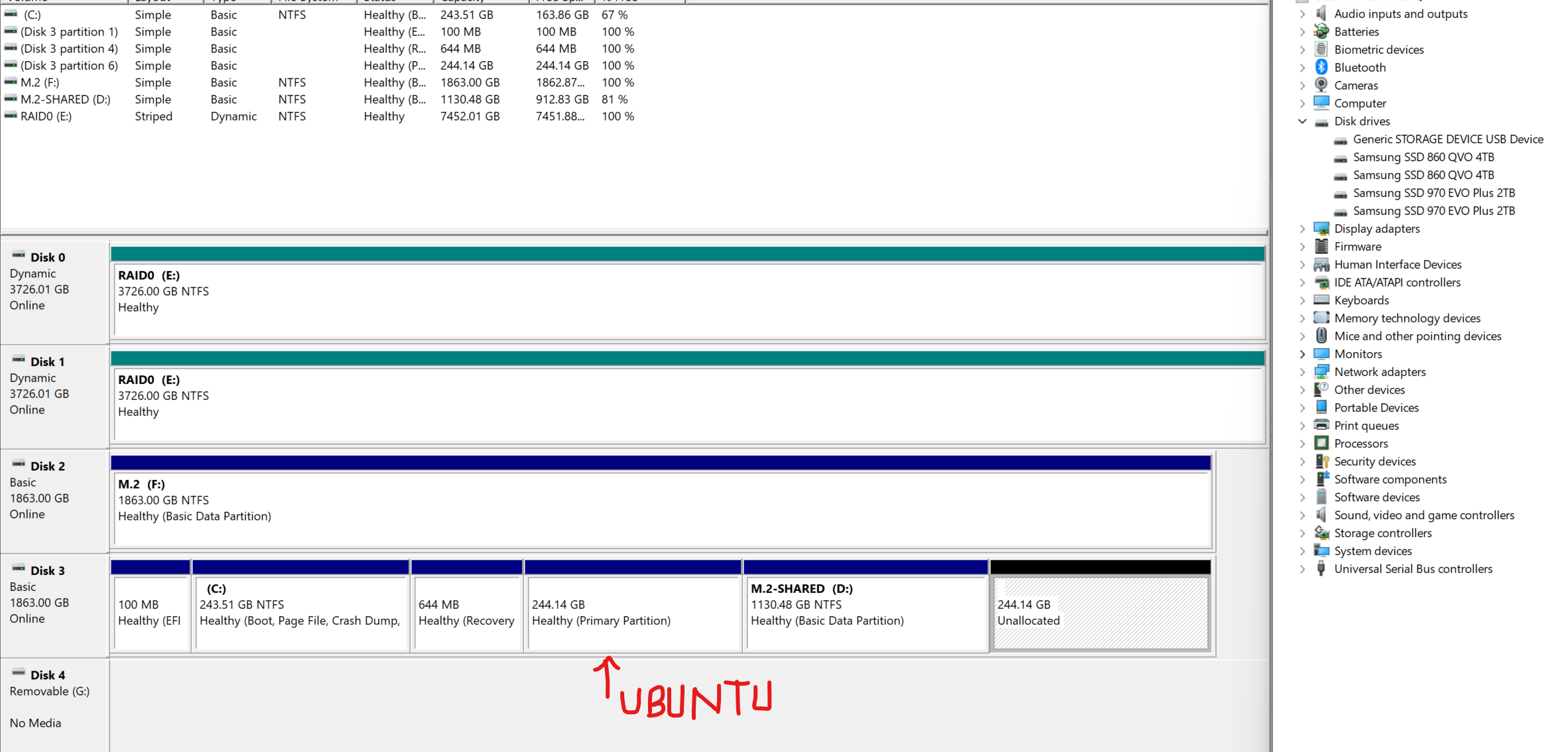Linux
--
Questions
--
Followers
Top Experts
Dual boot machine with both Windows 11 and Ubuntu on the same nvme.
It used to work fine for months, yesterday it worked, but when I rebooted ubuntu stays stuck at this screen.
The only thing I have installed yesterday was fuse
sudo apt install libfuse2and I installed Causality linux version, which was an AppImage that required fuse, hence the fuse installation:
https://www.hollywoodcamerawork.com/causality-download.html
Windows works fine, Linux Ubuntu Ubuntu 24.04 stays stuck at this screen.
nvme: nvme0 using unchecked data buffer
I have 2 nvme's, one for boot, has both Windows 11 and ubuntu, and one for storage.
I have logged in Windows 11 on the same machine and show in the image below where Ubuntu is installed, that just does boot and keeps hanging on the screen of the first image. Is it a hardware issue that nvme0 is not working? but then windows is working fine.
I'm now in grub command line and have no idea what to do.
Zero AI Policy
We believe in human intelligence. Our moderation policy strictly prohibits the use of LLM content in our Q&A threads.
Have you tried booting to a previous kernel version? Usually there are at least 2 other kernels left after an upgrade, You should be able to select the older kernels within your Grub menu, probably under advanced options. Perhaps there was an upgrade which broke something…
I'm also not too knowledgable about Appimage Apps, but aren't they supposed to be “self-contained”, without the need for other dependencies like fuse installed on the host?
I've no idea what to write in grub, don't even know what it is actually. I just found somewhere that I needed to go there, but then when I try to check with smartctl, it doesn't recognise it as a command.
I do not know how to boot to a previous kernel version, don't know if there is one.
Where do I find advanced options?
I'm new to Ubuntu and trying to switch permanently from windows.
Grub is the boot menu, if you setup the system the standard way (Windoze first, then added Ubuntu later), Ubuntu will have installed the Grub boot Manager. There you can select whether you want to boot Windoze, or Ubuntu. If you select Ubuntu, you should get further options, & there you should be able to select previous kernels to boot from.






EARN REWARDS FOR ASKING, ANSWERING, AND MORE.
Earn free swag for participating on the platform.
I have entered the advanced options,
and tried the two without recovery mode, but each takes me to a similar screen that gets stuck like the first one.
When I choose the recovery mode I get this:
No idea how to proceed
First do a fsck.
I have done first fsck (check all file systems), then dpkg (repair broken packages), then grub (update grub boot loader), and system summary
when I reboot same result, screen stuck at 1st image in the question.

Get a FREE t-shirt when you ask your first question.
We believe in human intelligence. Our moderation policy strictly prohibits the use of LLM content in our Q&A threads.
I noticed when I run fsck, and press yes I get the messages below “cannot continue, aborting”
I have also noticed when running fsck that there is some temporary failure
Try going to “root”, then run fsck from there. If that doesn't work, try booting to your ubuntu Install iso, it probably has GParted installed, if it does, run GParted from there, select your Ubuntu installation & select “check” from there, or if ubuntu doesn't include GParted in it's iso, download GParted directly & boot to that:
https://gparted.org/download.php






EARN REWARDS FOR ASKING, ANSWERING, AND MORE.
Earn free swag for participating on the platform.
I downloaded Gparted, put it in a usb drive with balenaetcher, booted from it and I got a few question then a while screen. When I right click on th escreen I get Fluxbox menu with a list:
Gparted
Terminals
Editors
File Manager
File system utils
Network config
Web browser
Calculator
fluxbox menu
Exit
and I do not know why I'm there in the first place, what am I even trying to achieve with Gparted?
I don't know etcher. I use ventoy. It has the advantage that once the USB stick is formatted via that tool, you just have to copy the iso file to it. A further advantage is that you can you can put as many isos on it as there is space for.
https://www.ventoy.net/en/index.html
I will use Ventoy, but what am I supposed to do with Gparted?

Get a FREE t-shirt when you ask your first question.
We believe in human intelligence. Our moderation policy strictly prohibits the use of LLM content in our Q&A threads.
I think I've managed to figure out X and Y.
is EFI for windows the same as for Ubuntu? I can see it's the one with 100MB, so Y=1. And X is 6.

But I get an error:
I have continued anyway:
and rebooted, removed the USB but it didn't work, I still get the same screen at the beginning of the question. Is it because of the warning that says I need to complete the grub setup manually?
Unable to resolve... nl.archive.... are upt update / upgrade failures, to find an IP address with a hostname. ie. Network configuration fail.
System seems (seemed) to load the OS, and possibly start working.
Is there a console somewhere?...
what do you mean is there a console somewhere? where should I look? and what should I do with the console?






EARN REWARDS FOR ASKING, ANSWERING, AND MORE.
Earn free swag for participating on the platform.
To me it looks as if there is a problem with your Linux Filesystem. With GParted you can do a “Check” on the ubuntu (& other File-Systems), something similar to chkdsk in Windoze, which can repair corrupted file-Systems. Such repairs can only be done while the File-System isn't mounted, so you have to do that by booting off some other media.
There is no point in reinstalling Grub as Shaun mentioned. Grub is working fine. Your problem lies elsewhere.
I'm now booting with a usb with “try Ubuntu”.
I'm in Gparted, but don't know how to proceed:
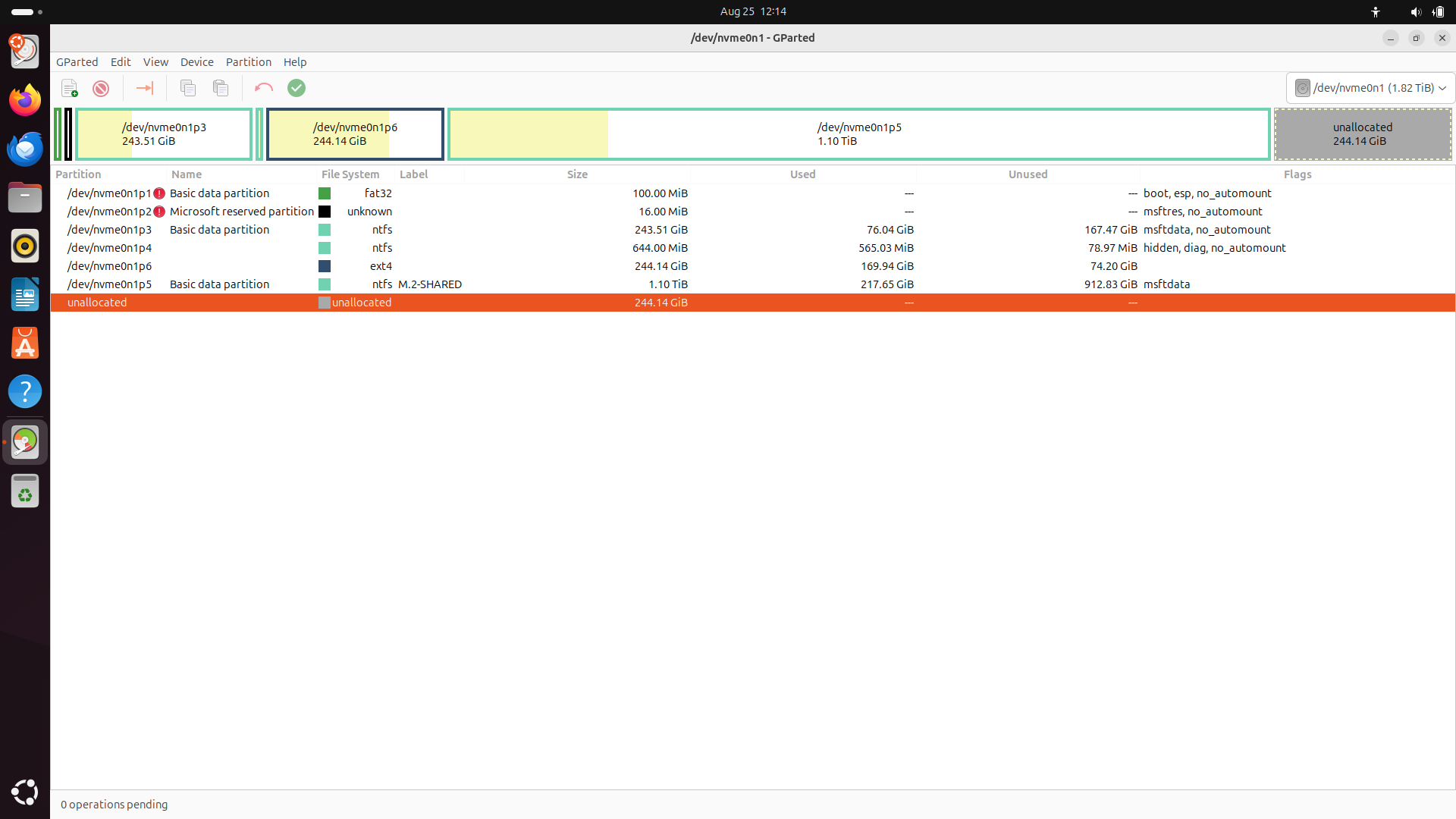
Select the “ext4” partition, that is where Ubuntu is installed. Then right click on that Partition& select “check”. After that click on green OK Checkmark in the menu to commit the change, & the the check & repair will start.

Get a FREE t-shirt when you ask your first question.
We believe in human intelligence. Our moderation policy strictly prohibits the use of LLM content in our Q&A threads.
Did it. what next?

Try booting normally again.
reboot, same problem






EARN REWARDS FOR ASKING, ANSWERING, AND MORE.
Earn free swag for participating on the platform.
When you have the root prompt, try removing fuse and Causality to see if it was problem.
And type in cat /etc/fstab, to see what could wait for a network file system.
So:
apt remove --purge libfuse2
apt install fuse3 gdm3Try removing libfuse2 first only
Have you done much in Ubuntu since you installed it? Have you considered re-installing it? It installs pretty fast, & if you haven't done much customising etc, you would probably not loose much.. Also consider using the HyperViser built into current Linux kernels, If you install that you can easily install other OS's (including Windoze & Ubuntu) as VM's .Then you can test things before you install them on your main OS.
You can install most of what is needed via:
sudo apt install virt-manager, & after that you have the GUI software in Ubuntu's “Administration” section, or whatever it is called. There you can easily create VM's, provided you have enough RAM & Disk-Space.
You should be able to get a text prompt with Ctrl+Alt+Fx, without booting on a usb stick

Get a FREE t-shirt when you ask your first question.
We believe in human intelligence. Our moderation policy strictly prohibits the use of LLM content in our Q&A threads.
remove libfuse2
install fuse3 gdm3
sudo apt remove --purge libfuse2
sudo apt install fuse3 gdm3= same problem
removed fuse3 gdm3, I've guessed this code from the previous one
sudo apt remove --purge fuse3 gdm3
how do I find causality to remove it?
If you have a /home partition, you can reinstall Ubuntu without losing data
sssd errors may lead to authentication failures, and failures to obtain the correct user credentials. (home directory, uid etc.).
Which may influence starting services.
w.r.t. the error please check message about the uncheck data buffer: https://github.com/storaged-project/udisks/issues/1408
most probably NOTHING wrong with your disks.






EARN REWARDS FOR ASKING, ANSWERING, AND MORE.
Earn free swag for participating on the platform.
When I last removed fuse3 gdm3 with
sudo apt remove --purge fuse3 gdm3
when I reboot, I get a very minimal text saying login: and when I type something and press enter, I get “password:”, apparently prompting for my password. I didn't proceed further because there is clearly something wrong with the GUI.
If there is nothing wrong with the disk, then how to solve the GUI issue, if that's the issue?
if you login with your username (after login) and password after password: then you are logged on.
You can also login as root IF you know the password for root (default ubuntu setup is a random generated password, only a regular user can login and use sudo).\
You indeed have to solve the GUI issues..., which may stem from the sssd error>....
in /var/log there are several logfiles, check the ones updates most recent after boot and verify for errors.
ls -latr /var/log will which files.
Other options: systemctl --failed
will show the failed services
journalctl -eu unit should show errors from systemd.
(use the unit name presented by the systemctl --failed command.
how do I restore the GUI as usual?

Get a FREE t-shirt when you ask your first question.
We believe in human intelligence. Our moderation policy strictly prohibits the use of LLM content in our Q&A threads.
/var/log/X..... or wayland in some logfiles.
Might be a related error in security /var/log/messages /var/log/security ...
etc. etc.
In short: Check the logs.....
If you removed fuse3 right before this error occurred, chances are fuse3 is a prerequisite for one of the services required to be able to start gdm....
Again the logs will tell you., start with
sudo journalctl -eu gdm
The "console" screen when in the gui is similar to the login you can have here.
Once you have logged in to Terminal, you can try using startx to get into the GUI. GDM is the GUI login manager, but you removed that, so now it only boots into the Terminal Session.
You should reinstall gdm as well: apt install gdm






EARN REWARDS FOR ASKING, ANSWERING, AND MORE.
Earn free swag for participating on the platform.
almost there. I get this:

how do I find out what is wrong?
I have tried
sudo systemctl --failedbut I get
UNIT LOAD ACTIVE SUB DESCRIPTION
0 loaded units listed.
when I use
ls -latr /var/logi get:
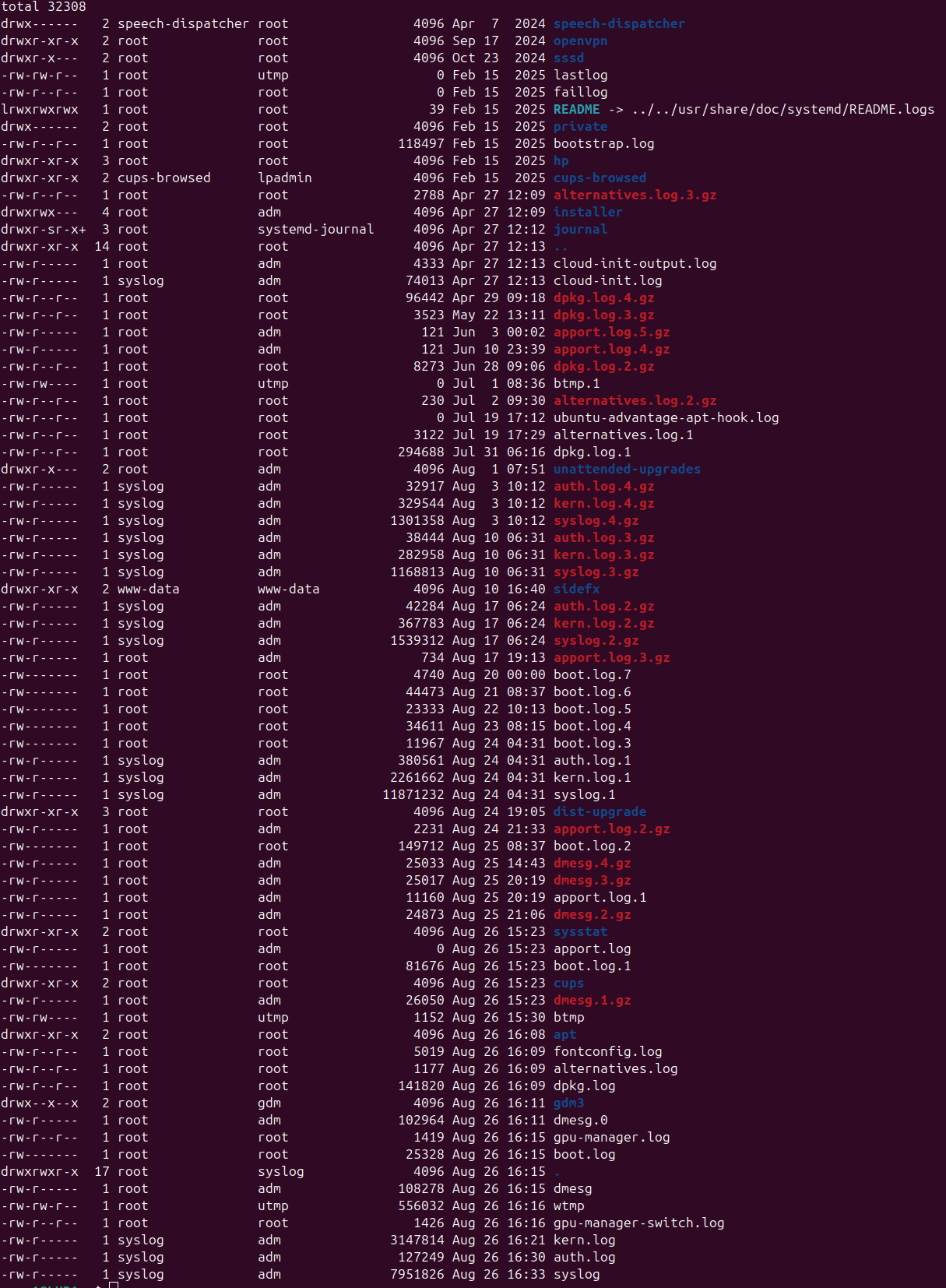
how do I find out what's wrong?
What is in dmesg..... (boot log).
what is in kern.log since last boot.
what is in auth.log since last boot.
what is i the syslog logging w.r.t. X, X11, gdm, errors, warnings?
gpu-manager.log is peculiar..., are you using the GPU for something else than GUI?
A GUI needs the GPU (Graphics Processing Unit...., what can also computer other stuff, which will harm access from the GUI to hardware).
where do I find and how do i open the dmesg, kern.log, auth.log, syslog, and gpu-manager.log?

Get a FREE t-shirt when you ask your first question.
We believe in human intelligence. Our moderation policy strictly prohibits the use of LLM content in our Q&A threads.
For dmesg, just type in dmesg -T at the command prompt. The logs are usually under /var/log and you can read them with less or cat
All files are in the /var/log directory.
so less /var/log/dmesg allows you to view & paginate though the file
To get the last 1000 lines from a file: tail -n 1000 /var/log/syslog
You can feed that to less as well for pagination: tail -n 1000 /var/log/syslog | less
Searching for the word error in a file: grep error /var/log/syslog
Case insensitive search: grep -i error /var/log/syslog
Replace the word error to search for another word.
Is this sufficient to access the data?
You can save results from programs to files....
f.e. store the result of the search for error to a file:
grep -i error /var/log/syslog >/tmp/error-from-syslog.tx
You can the use that file.
F.e. you can copy it elsewhere using ftp, scp, sftp etc.
When I clicked on report problem, after authentication I got this under details:
upper part of the details shows exactly when it happened the 24th of August, that's indeed when the problem occurred: gdm3 crashed with SIGTRAP in ffi_call()
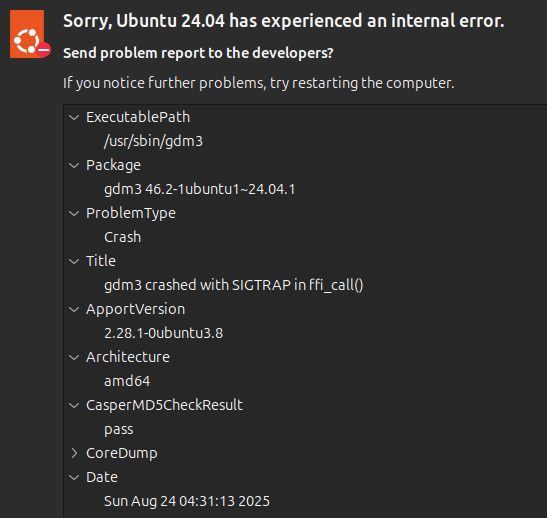
the whole screen:
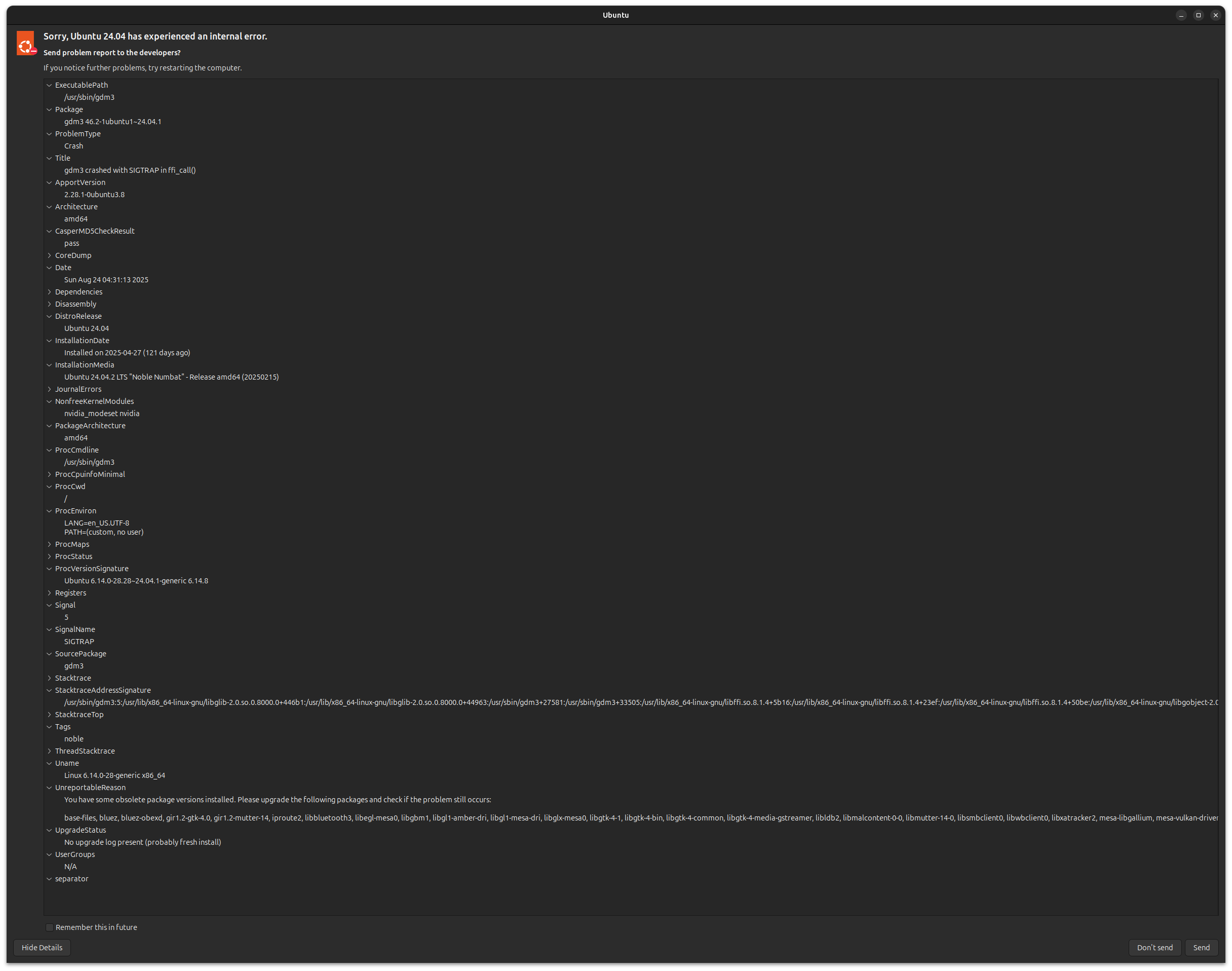
Digging further now, I see someone else had a similar issue also caused by installing fuse:






EARN REWARDS FOR ASKING, ANSWERING, AND MORE.
Earn free swag for participating on the platform.
sudo apt install --reinstall ubuntu-session
Seems to be the fix for this.
As always before some upgrade think of the backups....
Full Summary for reference
1. PROBLEM
In Ubuntu.
I downloaded an application that is an AppImage.
I couldn’t run it.
I searched online about how to install an AppImage in Ubuntu
I found this link: https://askubuntu.com/questions/1363783/cant-run-an-appimage-on-ubuntu-20-04
I copied and used the line
sudo apt-get install fuse libfuse2
then i realised I got the old line, copied and applied also the new line for ubuntu ≥ 22.04
sudo apt install libfuse2
I ran the AppImage, installed the application, have worked with the computer for the rest of the day, then shut down the computer.
Next morning, boom, Ubuntu dead.
2. SOLUTION
After help from Experts Exchange, I have tried a few things and reached the conclusion that the problem is: Fuse ruined gdm3. in technical terms it says “gdm3 crashed with SIGTRAP in ffi_call()”
and the solution, with hindsight, is to get to the Ubuntu partition, mount it, and reinstall gnome, because gdm3 is installed with gnome.
First get a usb that is max 32GB, format it as extFAT, and download Ubuntu image and put it in the usb with Balena Etcher or Rufus or ventoy or Similar.
Boot from the usb, using F12 or F7 or whatever keyboard in your case that loads the boot order, select the usb.
Choose Try ubuntu.
Open terminal, find out which partition is the Ubuntu partition and which is the EFI partition:
sudo lsblk
This will list the partitions. write down the /boot/efi and the ubuntu one.
Now it’s time to use the wonderful lines of code of Shaun Vermaak to mount the ubuntu partition and write code directly in the root:
Open a terminal and mount your Ubuntu root partition:
sudo mount /dev/nvme0n1pX /mnt # replace X with your Ubuntu partition number
sudo mount /dev/nvme0n1pY /mnt/boot/efi # replace Y with your EFI partition
Mount important directories so chroot works:
for i in /dev /dev/pts /proc /sys /run; do sudo mount -B $i /mnt$i; done
sudo chroot /mnt
get rid of fuse
apt remove --purge libfuse2
reinstall gnome, the is the key part
apt install --reinstall ubuntu-gnome-desktop gnome-session gnome-shell
Reboot and remove the USB. Your Ubuntu will launch as usual, you're good to go now. it’s done it’s solved.
3. Find out exactly what happened
At some point in time you’ll get a message that there was a “system program problem detected”, to find out what exactly happened press on “Report Problem”, click on details, and there it is showing you exactly what went wrong and when. It will state “gdm3 crashed with SIGTRAP in ffi_call()”.
There is also a section in details called “unreportable reason”, which will state something like “you have some obsolete package versions installed, please upgrade the following packages and check if the problem still occurs”. You may want to optionally upgrade these just to tidy up your Ubuntu installation.
But do you remember how it all started? I wanted to install An Appimage of an application, that seemed to require fuse, will that application still work while I have removed fuse? yes, don't ask me how, I've no idea, but it still works.
Appimage, is different from how Software is normally installed on Linux. Usually you use a package manager which pulls down the package, then also pulls down all the other required dependencies from the Distro's repositories so it can run.
The problem with this is that sometimes you have other incompatible dependencies installed, which other installed packages need. So they can't easily be installed on the same system. Appimage, snap & Flatpak use another approach. They package every dependency they need to run the software in the package, together with a kind own environment. That way it should then also run on other Distros without having to take into account each distro's specialities. But those software then also are more bloated & take up a lot more space. They often also won't get updates via the package manager, so you might have to keep current manually.
That's why in my first comment I mentioned that I was a little surprised that you needed fuse on Ubuntu to run that Appimage.

Get a FREE t-shirt when you ask your first question.
We believe in human intelligence. Our moderation policy strictly prohibits the use of LLM content in our Q&A threads.
Linux
--
Questions
--
Followers
Top Experts
Linux is a UNIX-like open source operating system with hundreds of distinct distributions, including: Fedora, openSUSE, Ubuntu, Debian, Slackware, Gentoo, CentOS, and Arch Linux. Linux is generally associated with web and database servers, but has become popular in many niche industries and applications.
